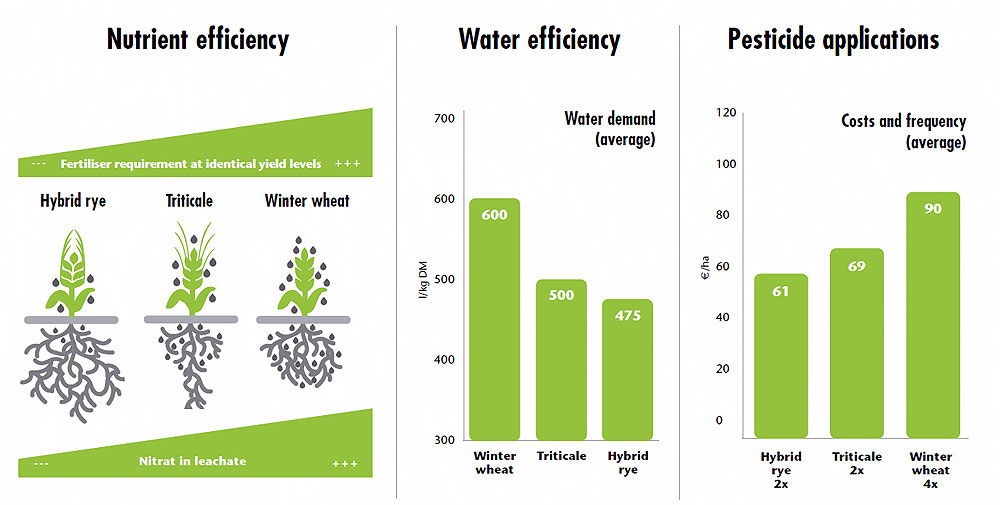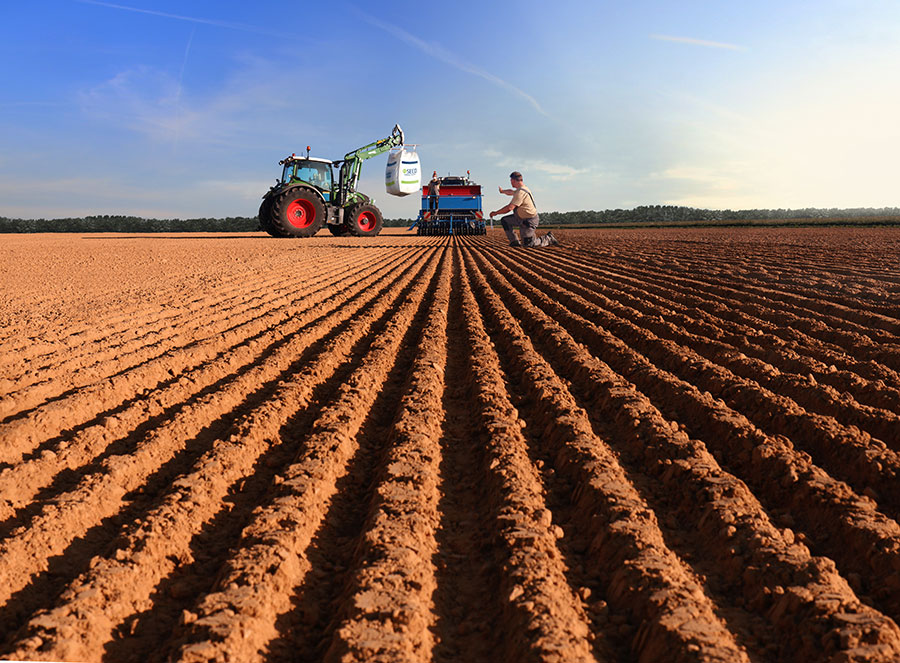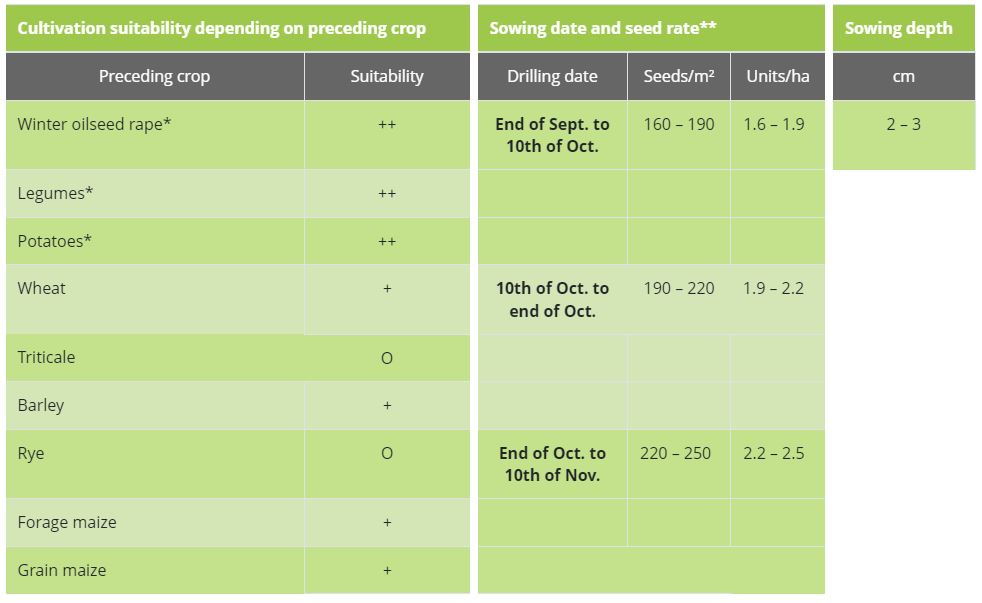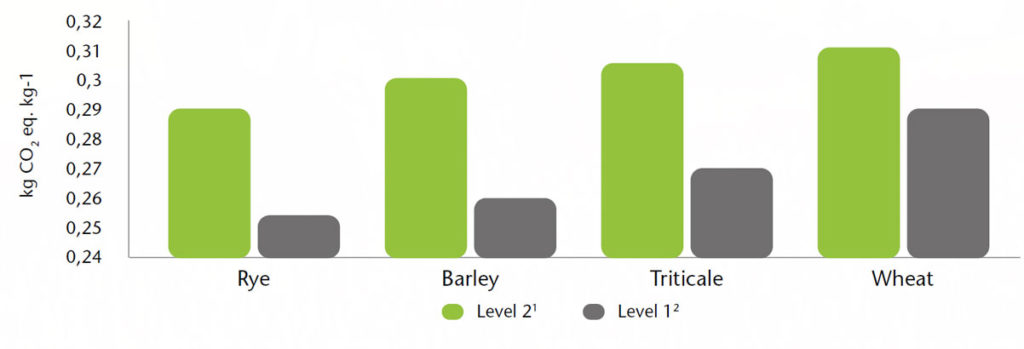Cultivation Advantages
As hybrid rye is very withstanding it is often grown on light soils. However, it also achieves competitive yields on better yielding soils. Due to its good root penetration hybrid rye requires less water and nutrients compared to other cereals. This is a benefit particularly in regard to new fertiliser regulation. Furthermore, rye has lower demands on plant protection.
Benefits of Growing Rye

Nearly all arable crops are suitable as a preceding crop for hybrid rye. In practice, however, rye often follows cereals or silage maize as the good effect of broad-leaved preceding crops is used for the more demanding wheat. Therefore, on arable farms and on higher yielding soils the cultivation of rye has been clearly reduced in recent years. On the one hand, this effected biodiversity and on the other hand it effected the cultivation of foliar healthy cereals. In general, focusing on short crop rotations increases production costs. On arable farms rye is mainly grown in the crop rotation as second cereal crop or continuous cropping. Livestock farms often grow forage maize as a preceding crop to rye. On sandy soils soil quality is usually the limiting factor. Therefore, due to the lack of profitable alternatives to rye crop rotations are limited. For sowing hybrid rye seed rates between 150 to 250 germinable grains/m² have proven successful. Economically, maximum yield can be achieved between 180 to 200 germinable grains depending on sowing date and soil conditions. (Reference seed rate calculator SU). Optimal planting depth is at 2 to 3 cm.

Hybrid Rye Agronomy Guide
Cultivation suitability depending on preceding crop
Sowing date and seed rate**
Sowing depth
Preceding crop
Suitability
Drilling date
Seeds/m²
Units/ha
cm
Winter oilseed rape*
++
End of Sept. to 10th of Oct.
160 - 190
1.6 - 1.9
2 - 3
Legumes*
++
Potatoes*
++
Wheat
+
10th of Oct. to end of Oct.
190 - 220
1.9 - 2.2
Triticale
O
Barley
+
Rye
O
End of Oct. to 10th of Nov.
220 - 250
2.2 - 2.5
Forage maize
+
Grain maize
+
*Favourable preceding crop but luxury as other following crops can make better use of the preceding crop.
**Average
++: best suitability, 0=medium suitability

*Favourable preceding crop but luxury as other following crops can make better use of the preceding crop.
**Average
++: best suitability, 0=medium suitability
Hybrid Rye Agronomy Guide
Nitrogen fertilisation Emphasis should be placed on starter application.
Fertilisation
Common practice
*Alternative splitting
Starter application
100 kg/ha - Nmin 0 to 30
** 170 kg/ha - Nmin + 20 kg S/ha
Stem extension (GS 30/31)
70 kg/ha - Nmin 30 to 90
/
Flag leaf application (GS 37/39)
/
/
*Favourable splitting, fertiliser is dissolved in soil before spring and early summer drought respectively – good experiences in practice.
**use of stabilised N fertiliser or slurry/fermentation residues
Note: consider fertiliser requirement calculations

*Favourable splitting, fertiliser is dissolved in soil before spring and early summer drought respectively – good experiences in practice.
**use of stabilised N fertiliser or slurry/fermentation residues
Note: consider fertiliser requirement calculations
Plant growth regulator
Necessity
2nd application if required
EC 31/32: 1 l CCC/ha + 0.3 l Moddus/ha
A second application could be necessary on better sites. Field checks!
Alternative: 0.6 kg Prodax/ha
.

Fungicide treatments
Depending on disease pressure
In general one treatment at GS 39/40 is sufficient. (Note: Choose fungicides with a good protective performance!)

Plant protection
Rye is considered as a very healthy crop but is not completely free of diseases such as soil-borne diseases, ergot, brown rust and Rhynchosporium. Snow mould, powdery mildew, black rust and soil-borne viruses vary in their regional significance. Brown rust, Rhynchosporium and powdery mildew are the most important diseases nationwide. However, they can be successfully controlled by fungicide treatments. Thanks to plant breeding, rye varieties with good brown rust resistance are now available. Fusarium head blight susceptibility is classified as being low in rye. Premature bleaching symptoms usually only occur on single spikelet’s. Infection of complete ear rows or even of the total ear does not occur naturally in rye. Snow mould can cause considerable winterkill. Only seed-born infestation can be controlled by seed treatments. Black rust is a dangerous pathogen that can occur in Germany and Austria during hot and droughty conditions. Damages can be severe as the fungus infests the stem and thus significantly restricts water and nutrient transport. Ergot infection is problematic. Deductions are made if rye for human consumption exceeds at delivery. Only batches with an ergot content of no more than 0.05 % by weight can be marketed as baking rye without deductions; for rye as animal feed the maximum threshold is 0.1 %. Contaminated harvested crops must be cleaned. Ergot should be completely avoided in the food chain. Variety choice is only one influencing factor but in years favouring infection it is far from being sufficient to control the problem. A range of measures must be taken including appropriate cultivation measures and in particular thorough cleaning carried out by the dealers.
Nutrition/water efficiency
Rye is the most N-efficient cereal. Nevertheless, nutrient supply must be ensured by targeted fertilisation in order to make full use of the yield potential. Depending on yield expectations and site conditions N requirement of rye is between 130 to 170 kg N/ha incl. Nmin. If N supply is too high rye is prone to lodging causing problems such as regrowth. According to the new fertiliser regulation (2017) for example, at an expected yield of 7.0 t/ha,170 kg N/ha incl. Nmin can be applied. Please take the required additions and deductions of the new fertiliser regulation into account (e. g. organic fertilisation). In the year 2019/2020 for the first time we have started to carry out our own experiments on nutrient and water efficiency. For more information see “Projects & trials”.
CO2-Footprint
The CO2 footprint is an important tool for assessing climate impact. In a Polish study it could be shown that rye has the lowest CO2 footprint measured by emissions resulting from intensive/extensive cultivation (level 1/ level 2)*.
CO2 Footprint

*Cemdirbyste-Agriculture, vol. 103, No. 3 (2016), p. 259-266
1 Trials are carried out with growth regulators and fungicide treatments
2 Trials are carried out without growth regulators and fungicide treatments
